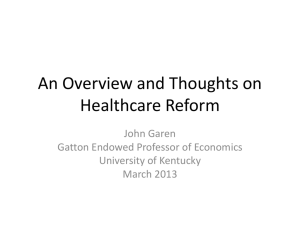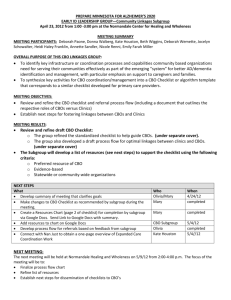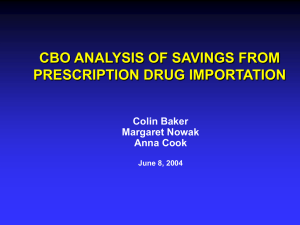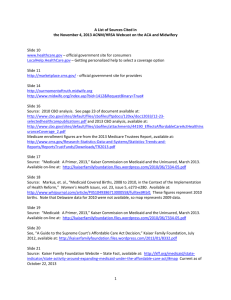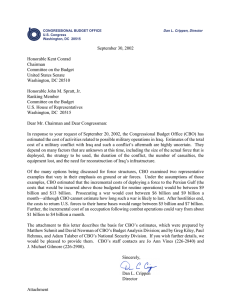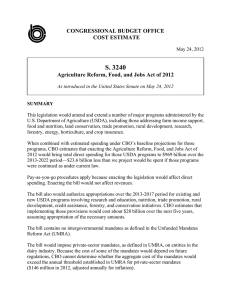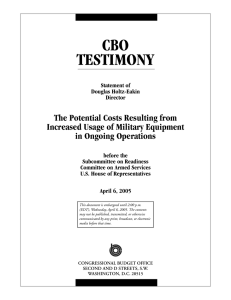Health Costs and the Federal Budget Douglas W. Elmendorf Director
advertisement
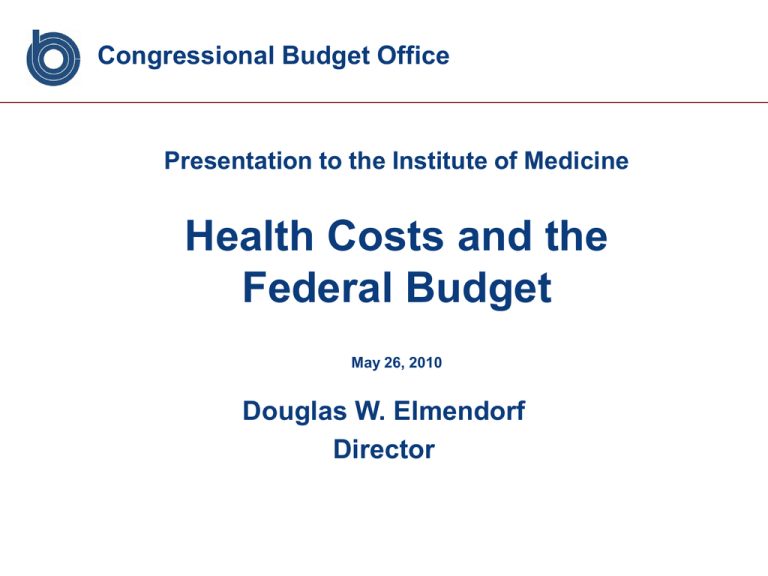
Congressional Budget Office Presentation to the Institute of Medicine Health Costs and the Federal Budget May 26, 2010 Douglas W. Elmendorf Director The Challenge Rising health costs will put tremendous pressure on the federal budget during the next few decades and beyond. In CBO’s judgment, the health legislation enacted earlier this year does not substantially diminish that pressure. 2 Components of the Federal Budget 2020 1970 2007 March Baseline Percentage of GDP Revenues 19.0 18.5 20.3 Outlays 19.3 19.6 23.3 Medicare and Medicaid 0.7 4.0 5.9 Social Security 3.1 4.3 5.2 Defense 8.1 3.9 3.6 Other mandatory spending, nondefense discretionary spending, and net interest 7.5 7.5 8.5 0.3 1.2 3.0 Deficit Note: Figures are shown net of offsetting receipts where relevant, and exclude the effects of the Patient Protection and Affordable Care Act (Public Law 111-148) and the Reconciliation Act of 2010 (Public Law 111-152). 3 Projected Spending for Medicare Parts A and B Billions of dollars Note: SGR = Sustainable Growth Rate; MEI = Medicare Economic Index. Projections are a crude approximation based on CBO’s March baseline and published cost estimate of the effects of the Patient Protection and Affordable Care Act (PPACA, Public Law 111-148) and the Reconciliation Act of 2010 (Public Law 111-152). 4 Projected Spending for Medicaid, CHIP, and New Health Insurance Subsidies Billions of dollars Note: CHIP = Children’s Health Insurance Program. Projections are a crude approximation based on CBO’s March baseline and published cost estimate of the effects of the Patient Protection and Affordable Care Act (PPACA, Public Law 111-148) and the Reconciliation Act of 2010 (Public Law 111-152). 5 Effect on the Deficit of the Main Elements of This Year’s Health Legislation Billions of dollars Source: Goldman Sachs based on CBO estimates. Note: Figures exclude the effect of education provisions in the Reconciliation Act of 2010 (Public Law 111-152). 6 CBO’s Estimates of the Longer-Run Effects of This Year’s Legislation CBO defines the ―federal budgetary commitment to health care‖ as the sum of net federal outlays for health programs and tax preferences for health care. The legislation will increase this commitment by nearly $400 billion during the 2010-2019 period but reduce it in the following decade. The legislation will reduce budget deficits by about $140 billion during the 2010-2019 period and by an amount in a broad range around one-half percent of GDP during the following decade. 7 Federal Revenues and Noninterest Spending Under CBO’s Alternative Fiscal Scenario Percentage of GDP Notes: Projections are from CBO’s June 2009 Long-Term Budget Outlook and exclude CBO’s subsequent updates to the budget outlook as well as the effects of the Patient Protection and Affordable Care Act (Public Law 111-148) and the Reconciliation Act of 2010 (Public Law 111-152). 8 Critiques of CBO’s Estimates of the Effects of This Year’s Health Legislation CBO has mis-estimated the effects of the changes in law. – Some observers think that subsidies will be more expensive than we project. – Some observers think that Medicare reforms will save more money than we project. – CBO’s estimates take into account the views of a variety of outside experts (including those on our Panel of Health Advisers), and aim to be in the middle of the wide range of possible outcomes. Budget conventions hide or misrepresent certain effects of the law. – The legislation will lead to an increase in discretionary spending, which is not included in the estimates mentioned earlier. – Cost estimates do not include any effects of legislation on overall output. – The discretionary costs are subject to future appropriation action; some of the authorized activities may not receive funding—and others would have been funded in any event. 9 Critiques of CBO’s Estimates (cont.) The law will be changed in the future in ways that will make deficits worse. – CBO estimates the effects of proposals as written and does not forecast future policy changes. – We have emphasized that the legislation maintains and puts into effect a number of policies that might be difficult to sustain over a long period of time. For example, the legislation reduces the growth rate of Medicare spending (per beneficiary, adjusting for overall inflation) from about 4 percent per year for the past two decades to about 2 percent per year for the next two decades. 10 Reducing Growth in Federal Health Spending On the upside: – There is considerable agreement that a substantial share of current spending on health care contributes little if anything to people’s health. – Providers and health analysts are making significant efforts to make the health system more efficient. On the downside: – It is not clear what specific policies the federal government can adopt to generate fundamental changes in the health system. That is, it is not clear what specific policies would translate the potential for significant cost savings into reality. – Efforts to reduce costs increase the risk that people would not get some health care they need or would like to receive. 11 Factors Explaining Future Federal Spending on Medicare, Medicaid, and Social Security Percentage of GDP Notes: Projections are from CBO’s June 2009 Long-Term Budget Outlook and exclude CBO’s subsequent updates to the budget outlook as well as the effects of the Patient Protection and Affordable Care Act (Public Law 111-148) and the Reconciliation Act of 2010 (Public Law 111-152). 12 Conclusion Putting the federal budget on a sustainable path would almost certainly require a significant reduction in the growth of federal health spending relative to current law (including this year’s health legislation). 13

